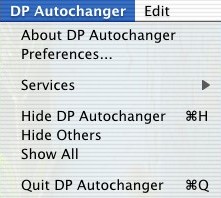
DP Autochanger 2.0 is a vast improvement to prior versions of the program, combining functions of the DP Autochanger program and the editor. Now it is possible to change DP Autochanger’s settings without using a separate program. It retains the ability to change pictures automatically and, as before, those pictures can come from either the file system or from the web. A new “About” box provides status information at any time. URL or picture files can be dropped on the Dock icon to change the picture immediately.
DP Autochanger operation is a simple matter. You must select Preferences from the DP Autochanger menu when you run DP Autochanger for the first time.

You will see the DP Autochanger Preferences window:
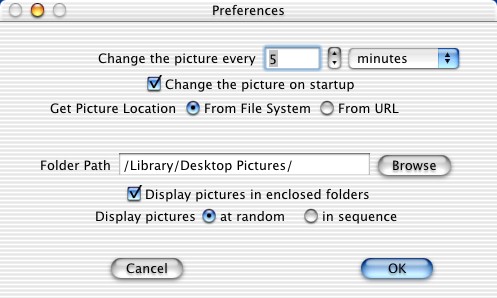
The interval at which the picture changes is set at the top. You can type a number from 1 to 300 in the box, or you can click on the little arrows to increase or decrease the number by one unit at a time. You can select the time unit from the popup menu allowing you to enter a change time from 1 second to 300 days.
Note: DPA 2 can change the picture every second, but this is not recommended. This much activity can cause a Finder crash after it goes on for some time. 5-6 seconds appears to be a safe interval.
To understand what the next buttons do, you need to know where DP Autochanger gets the pictures that it displays on the desktop (actually, DPA doesn’t display the pictures. It tells the Finder to display the pictures).
DP Autochanger gets pictures through the file system or from the net. Let’s discuss the file system pictures first. If you click the “From FileSystem” radio button, DP Autochanger will select a picture from a folder that you specify using the file system on your computer. If that button is selected, the rest of the preferences window will look as it does above, because the rest of the options deal with data files already known to the Finder.
The Folder path is the path (in slash, or POSIX, form) to the folder that contains the pictures you want to display. You can either type in a path, or you can click the Browse button to bring up the standard file panel to choose the folder.
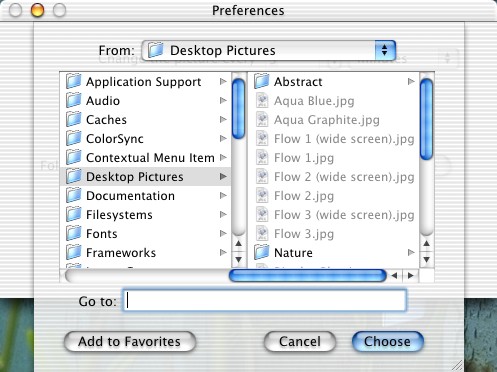
Caution: Because of the mixed heritage of Mac OS X (i.e., Mac OS and Unix), DP Autochanger doesn’t like to see file paths that contain file or folder names that have either slashes (/) or colons (:). Please make sure that none of the folders or files that you use with DPA contain either of these characters.
You may have pictures organized into folders, but you still want to display all of them. The next check box lets you do this. If it is checked, DP Autochanger will look inside the chosen picture folder, all of the folders inside the chosen picture folder, all of the folders inside each of them and so on, to make a list of all these pictures to display.
Finally, with respect to files, you can choose to display the pictures in alphanumeric sequence or at random. In either case, DP Autochanger will ensure that all the pictures are displayed within a given cycle. In sequence treats the order from the point of view of the selected folder. For example, if you had inside your picture folder a folder named “animals” and one named “tools”, the file “zebras.jpg” inside “animals” would display before “anvil.gif” inside “tools.”
As mentioned above, DP Autochanger can also display pictures from the net. Strictly speaking, DPA first downloads pictures from the net to ~/Library/Preferences/DPA Pictures/ ( i.e., a folder called DPA Pictures in the Preferences folder of the currently logged on user) and displays the picture from there.
You can download any picture URL from the web on a timed basis. This doesn’t make a lot of sense for most pictures, but if there is an unchanging URL that points at a picture that changes, it can be interesting. This is usually a webcam, which is a camera that feeds a live image to a web page. It is not limited to that; other examples are traffic and weather conditions.
When you click “From URL”, the Preferences window changes:
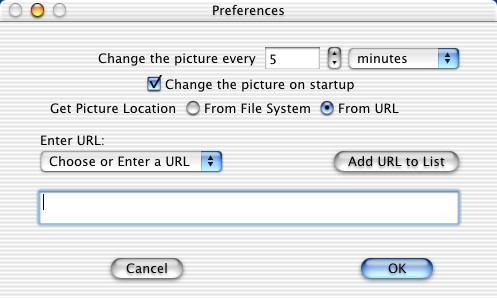
You can enter the URL in the text box by typing or pasting. You can also select from the popup “Choose or Enter a URL” menu.
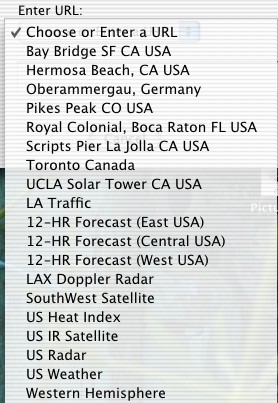
This menu is populated from a file that you can edit. It is located at ~/Library/Preferences/URLs.txt (the Preferences folder in the Library folder of the current user’s home folder). You can delete lines that have URLs that you are not interested in, or that no longer work. This file can be edited with a text editor such as BBEdit, Tex-Edit or SimpleText, but make sure you save it as a text file. TextEdit, the editor which comes with Mac OS X, should not be used, because it cannot save text files.
It is easy to add URLs to the list. After you have entered a URL you like, click the “Add URL to List” button.
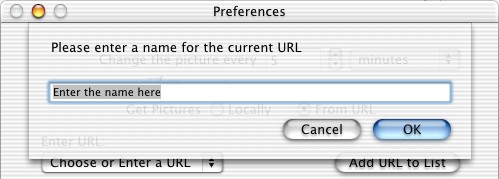
In this panel, enter the name you would like displayed in the popup for the URL.
So, these are the two methods of getting pictures. But what if you want to mix them? What if you want to use a combination of URLs or show some local pictures and some URLs? DP Autochanger can handle this as well, through the “From File System” option.
There are several kinds of files in Mac OS that can contain URLs that DP Autochanger can display. One or more URL files can be put into the picture folder selected in the Preferences window. A URL file is a file that contains a URL, such as a Mac OS URL clipping file, or a browser URL file. A Mac OS URL clipping file is created by dragging URL text to the desktop. Browser URL files are created by dragging the icon next to the field where you type where you type in the browser to the desktop. The URL should point directly at a picture, not to the html page that contains the picture.
After you click “OK” in the Preferences window for the first time, the DP Autochanger Shareware reminder will appear:
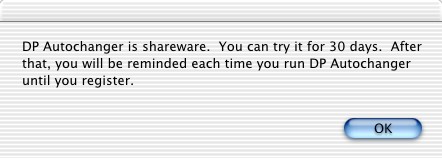
As the message says, this will not bother you again for 30 days, and then a request for the registration key will appear each time you start DP Autochanger. See below for registration information.
Drag & Drop Operation
DP Autochanger will accept files and folders dropped on it. You can drop whether DP Autochanger is running or not. If you drop a picture or URL file on DP Autochanger, it will immediately display the picture as the desktop picture. At the next interval, a picture from the currently selected folder will replace it. If you drop a non-picture file on DP Autochanger, it will advise you:

If you drop a folder on DP Autochanger, that folder will be checked for image or URL files. If they are found, DP Autochanger will use the dropped folder for its picture folder and subsequent pictures will be chosen from that folder.
DP Autochanger Hints and Tips
One of DP Autochanger 2.0’s most exciting new features is the About box. Choosing “About DP Autochanger” in the DP Autochanger menu produces this window:
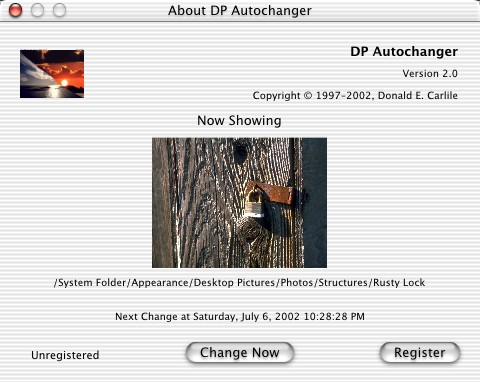
In addition to the version and copyright information, this window provides several other items. First, the current Desktop Picture is displayed in the middle of the window. Right below is shown the path to the file on your disk or the URL that is being displayed. If there is an error with the URL, a message telling you that will appear here instead. The text in this area can be selected and copied.
Below that, the time of the next change is displayed. In the lower left, the registration status is displayed. In the lower middle, is a button that will cause DP Autochanger to change the Desktop Picture immediately. In the lower right is the button you can use to enter the registration code for DP Autochanger.
The Finder uses QuickTime to translate the picture formats for the Desktop Picture. QuickTime can read the following formats:
* BMP (Windows Bitmap)
* FlashPix
* GIF
* JFIF/JPEG
* MacPaint
* Photoshop
* PNG
* QuickDraw Picture (PICT)
* QuickDraw GX Picture
* QuickTime Image File
* Silicon Graphics Image File
* Targa Image File
* TIFF
* PDF
Paying for DP Autochanger
DP Autochanger has the following pricing. Single user licenses, $5 per user. A Site License costs $250 (equal to 50 users) and covers all locations for your organization within a 160 kilometer radius of your site (100 miles). One big advantage of a Site License is that you do not need to keep track of how many people at your site are using the software. A World-Wide License costs $1000 and it covers all locations for your organization on the planet Earth.
Paying for DP Autochanger is fairly simple. You can either register online, or you can
use the Register program that you downloaded with the program.
If you choose not to register online, open the Register program that accompanies DP Autochanger. Enter your name, your email address, and the number of single user licenses you desire for each program you wish to purchase (or Site or World-Wide licenses). Save or Copy or Print the data from the Register program and send the data and payment to Kagi. Kagi is one of the companies that handle Quandir’s payment processing.
If paying with Credit Card or First Virtual, you can email or fax the data to Kagi. Their email address is [email protected], and their fax number is 1 510 652-6589. You can either Copy the data from Register and paste it into the body of an email message, or you can Save the data to a file and attach that file to an email message. There is no need to compress the data file; it’s already pretty small. If you have a fax modem, just Print the data to the Kagi fax number.
Payments sent via email are processed within 3 to 4 days. You will receive an email acknowledgment when it is processed. Payments sent via fax take up to 10 days, and if you provide a correct Internet email address you will receive an email acknowledgment.
If you are paying with Cash or USD Check, you should print the data using the Register application and send it to the address shown on the form, which is:
Kagi
1442-A Walnut Street #392-DC
Berkeley, California 94709-1405
USA
You can pay with a wide variety of cash from different countries, but at present if you pay via check, it must be a check drawn in US Dollars. Kagi cannot accept checks in other currencies. (The conversion rate for non-USD checks is around USD 15 per check and that is just not practical.) If you have a purchasing department, you can enter all the data into the Register program and then select Invoice as your payment method. Print three copies of the form and send it to your accounts payable department. They must include a copy of the form with the payment. Kagi can not invoice your company, so you need to generate the invoice and handle all the paperwork on your end.
Please do not fax or email payment forms that indicate Cash, Check or Invoice as the payment method. Payments sent via postal mail take time to reach Kagi and then up to 10 days for processing. Again, if you include a correct email address, you will hear from Kagi when the form is processed.
If you do not have an email address, please enter your complete postal address. Please remember we do not know what country you live in, so please enter that into the postal address also. If you do not have an email address, you should consider selecting the Postcard Receipt so that Kagi can inform you of your registration key. Kagi transmits the registration keys via email and paid postcard receipt only.
As noted above, after 30 days DP Autochanger will remind you about paying the shareware on each startup until you enter the registration key. When you pay, you will be sent a key. You can either enter the key in DP Autochanger when it asks, or you can select About DP Autochanger and click the Register button and enter it.